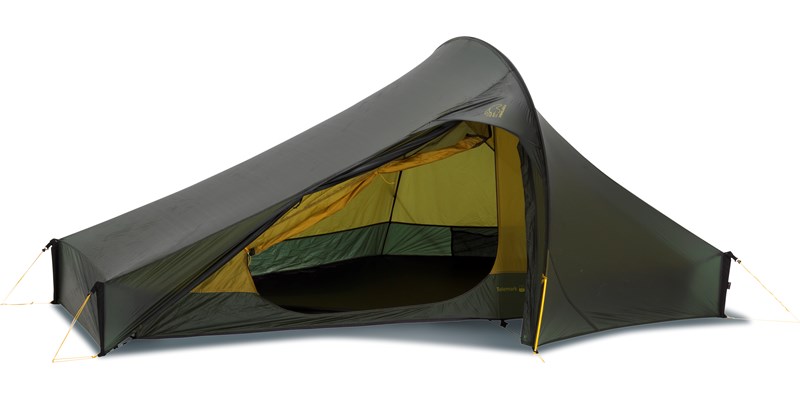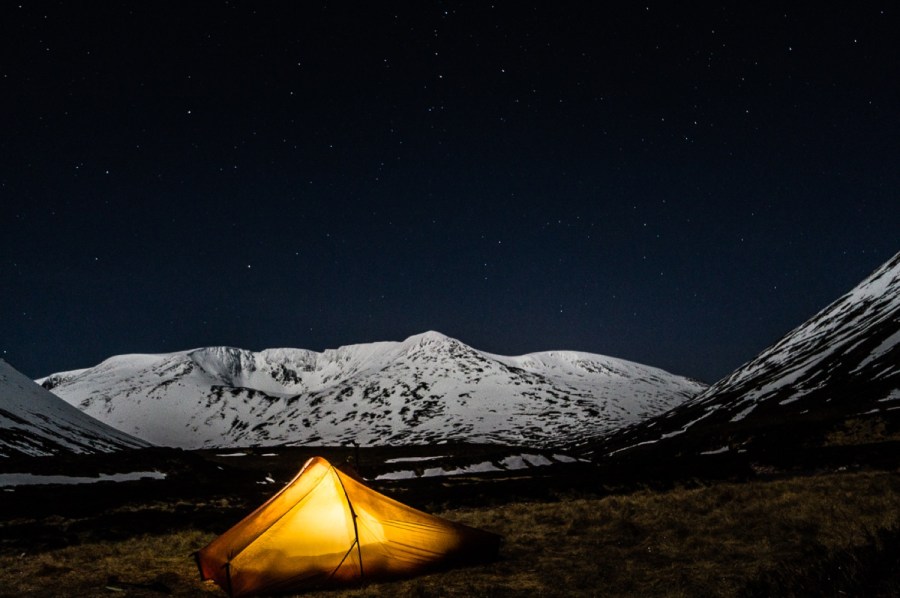The Nordisk Telemark 2 ULW, which won best camping product in a previous instalment of our TGO Awards, is among one of the world’s lightest two-man tents
The Nordisk Telemark 2 tent is certainly very light and roomy enough, just, for two people to lie down inside, though there’ll be little room for gear or cooking and one of them will be against the back wall. For mountain marathons and adventure races where weight is more important than comfort I can see this being acceptable. For most backpackers and campers I think this is better regarded as a one person tent. It weighs less than most solo tents anyway.
The Telemark 2 is a single hoop tent with short poles at each corner, a well-established design for providing space and stability at a low weight. However unlike similar tents the hoop on the Telemark 2 is offset so that the high point is towards one end of the tent. As long as you sleep with your head at that end this works better when you sit up in your sleeping bag. The tent pitches as a unit or flysheet first and can be pitched in a couple of minutes. Just four pegs are needed and it comes with four very nice ultralight titanium V-pegs. However for maximum security in storms guylines can be added to the pole and each end pegged down as well, which requires four more pegs.
To keep the weight down the flysheet fabric is very thin, as is the groundsheet. However both seem pretty tough. There’s a covered mesh vent over the top of the two-way flysheet door zip and a mesh panel in the inner door. That’s it for vents. Inner and outer doors are held open by clips and loops. I found these hard to fasten and unfasten with cold fingers and they’re not ideally positioned to hold the doors in place without some fabric dropping down. The loops could do with being a bit bigger and maybe placed lower down.

A curious feature I haven’t seen in any other tent is the option of removing three of the corner poles, slotting them together and using the resulting single pole to support the flysheet door to make an awning. A guyline is provided to support the pole. I didn’t find this practical though. Firstly, when the corner poles are removed the tent sags a little at the ends. And putting the poles back when it’s cold and wet is quite difficult. I’d rather use a trekking pole to make an awning, which has the advantage that if you want to close the door you just have to detach the pole from it rather than go outside and reinsert the corner poles. The biggest disadvantage though is that in strong winds the corner poles can protrude out of their sleeves, making the tent flap more. I think these sleeves should have a Velcro tab over the top to prevent this happening. As they don’t I’d be inclined to sew them shut or stick tape over the top.
Another unique feature but this time one I really like is the ability to vary the size of the porch by simply sliding a locking ring along the tape between the ends of the main pole. With maximum space in the inner the porch is small with not enough room to store much gear or for safe cooking. However when needed a bigger porch can be made in seconds. On a very windy and wet morning with the tent flapping a fair bit I was able to safely use an upright stove in the expanded porch. There was still plenty of room in the inner for me too. With two people it would be more difficult as you’d need the extra inner space.
For one the Telemark 2 is spacious, even with the inner space reduced. Head room is good at the high point and the tent is quite long. The ends are low however and this could be a problem if using a thick air mattress. I had room in the inner for my rucksack and most of my gear. Then, when the rucksack was wet, I expanded the porch and stored it plus wet waterproofs in it. This simple system really is versatile.
After an initial low level test I took the Telemark on a two-night trip in the Cairngorms, camping in exposed spots at around 600 and 700 metres. The first night was frosty to begin with and even with the door pegged out as an awning there was soon frost all over the inside of the flysheet. Later in the night the air warmed up and it grew windy. Condensation flicked onto the inner but none came through and I was able to avoid contact with the walls and keep my down sleeping bag dry. During the second night the wind increased in strength and by 4 am was buffeting the tent. The end walls were pushed in by the gusts but the main pole barely moved. Knowing I wouldn’t get any more sleep I decided to make an early start in the dark. Outside the wind was gusting to 50mph. The tent, amazingly, was still secure. That’s impressive for a tent this light.
Nordisk gives the weight as 880 grams. After I’d added two guylines, four pegs and a stuffsack for the tent and another for the pegs the total weight came to 994 grams, still very light for a roomy solo tent. The Nordisk does come with a stuffsack but this is very small and I found it hard to get the dry tent into it with warm hands in calm weather. I think I’d find it just about impossible in a storm. There is a slot for the pegs in the pole stuffsack but I couldn’t fit the four extra pegs in there, hence the separate stuffsack.
The Telemark 2 has some minor imperfections but overall it’s an excellent ultralight solo tent and well worth considering by any backpacker looking to keep weight down.
Bear in mind, if you like the sound of this but want something with a little more space, it’s worth considering the newer 2.2 version of this. It’s essentially the same tent but it has a door on either side, making it a bit more comfortable for two people.
More info: nordisk.eu








